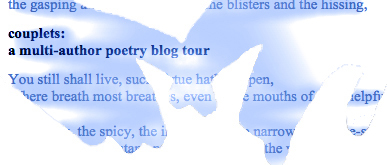Today’s Couplets interview is with Kate Buckley. Her poems have appeared in Bellingham Review, The Cafe Review, North American Review, Shenandoah, Slipstream and numerous anthologies. She holds an MFA from Spalding University and is the author of A Wild Region (Moon Tide Press, 2008) and Follow Me Down (Tebot Bach, 2009). A three-time Pushcart Prize nominee, her awards include a Gabeheart Prize and the North American Review‘s James Hearst Poetry Prize. She is also a visual artist, and her work can be seen in A Wild Region and at her online gallery.
Joanne Merriam: What is your writing process?
Kate Buckley: Like many writers, I write best when I disengage my self-censor or ego-mind. I often find that meditative or repetitive activity (walking, yoga, gardening) assists in clearing my head before approaching the page. And once there, I tend to approach poems as puzzles. Even after several drafts have been written, I still work at fitting together the pieces, playing with sound, word choice, line breaks and arrangement till I feel the poem has achieved both structure and surprise. I work quite a lot in form so I often try a poem in several different forms to see which structure or “body†suits the soul of the poem. And often I’ll abandon the strict form all together, but it’s nonetheless present in the making of the poem—just as a scaffolding is used in the construction of a building then removed once it can stand alone.
Joanne Merriam: As a Southerner who has until recently been living in California, how does geography (or any other sense of place) inform your work?
| Kate Buckley: You’ve hit on one of my pet topics here! Geography or landscape (whether that of my native Kentucky or my adopted land of California) plays a tremendous role in my work. I think landscape acts as an interrogator; meaning that there are many times when a particular landscape will bring up a sensation or idea, something that compels a response. And memory looms large in that equation—where was I when I last saw a leaf so moth-eaten? When did I last see the snow? What happened the summer there was no rain?
I now divide my time between Nashville and Newport Beach and I value the variety in their landscapes—and climes. When I’m in Southern California, I miss autumn with a vengeance, as well as attics and basements. Whatever would Freud have done had he been raised in Oceanside? But then I walk by the reckless ocean, run my fingers through tide pools and then the kaleidoscope of the world shifts yet again. |
 |
I’ve also the theory that Southerners are more connected to the ideas of landscape and home than others, or certainly more inclined to write about place. The South has endured so much—and caused so many to endure so much more—that perhaps the very soil is imbued with pathos, echoes, reverberations of the cries of those that died in its grasp. There is a pretty fascinating theory about energetic transference as applies to land or objects (when something awful or tragic has occurred, the imprint of that energy remains). I don’t know why that wouldn’t apply to the South, more than almost anywhere else in the United States.
Joanne Merriam: Do you think writing poetry helps you to understand more about yourself and the world, or is advancing as a poet more about learning how to communicate the things you already know?
Kate Buckley: I think both are true. Muriel Rukeyser said, “One writes in order to feel.†Katherine Hepburn said, “Just write the best you can about the things that concern you most.†I agree with both sentiments. I try to write through deep feeling to attempt stabs at universal truths. I also try to write about the things that concern me most, both as an artist and as a human being.
Joanne Merriam: How do you decide how to structure your books, so that your poems work together to support each other, or create interesting tensions, or a narrative? Has your process changed at all since your first two books?
 |
Kate Buckley: I read widely to learn from others. When I was putting together A Wild Region and Follow Me Down , I’d pull titles from shelves and study how poets whose work I particularly valued had structured their books. I’d look at different ways of ordering and creating structure, movement and dynamism: biographical, thematic, circular, etc.
And the books came together differently. For instance, the poems in my first book, A Wild Region, seem particularly visual and imagistic to me so I made the decision to include artwork alongside the poems (I’m also a visual artist). From there, it seemed appropriate to display the poems side-by-side with the particular paintings that I felt spoke to the thematic content in these poems, moving toward a narrative arc. Follow Me Down came together thematically in three distinct sections—the entire book is concerned with the nature of memory and the sections came to be: “Inventing Memory,†“Fugue States,†and “The Ghosts of Houses.†And with both books there was a lot of spreading poems all over the dining room table, floor, corridors, playing hopscotch with their pages, searching for intersections, relationships, shapes, architecture—interlocking angles of the structure I was trying to build. |
I’m now working on my third book—a book of sonnets, or “ghosts†of sonnets; my attempt to, in the kind words of my MFA mentor, Molly Peacock, “put a 21st-century California spin on the sonnet.†I don’t know that my structuring process has changed dramatically since I put together my first two books, but I’m looking forward to learning all I can from this process.

Check out more poetry-related interviews, reviews and guest posts at Couplets: a multi-author poetry blog tour.
